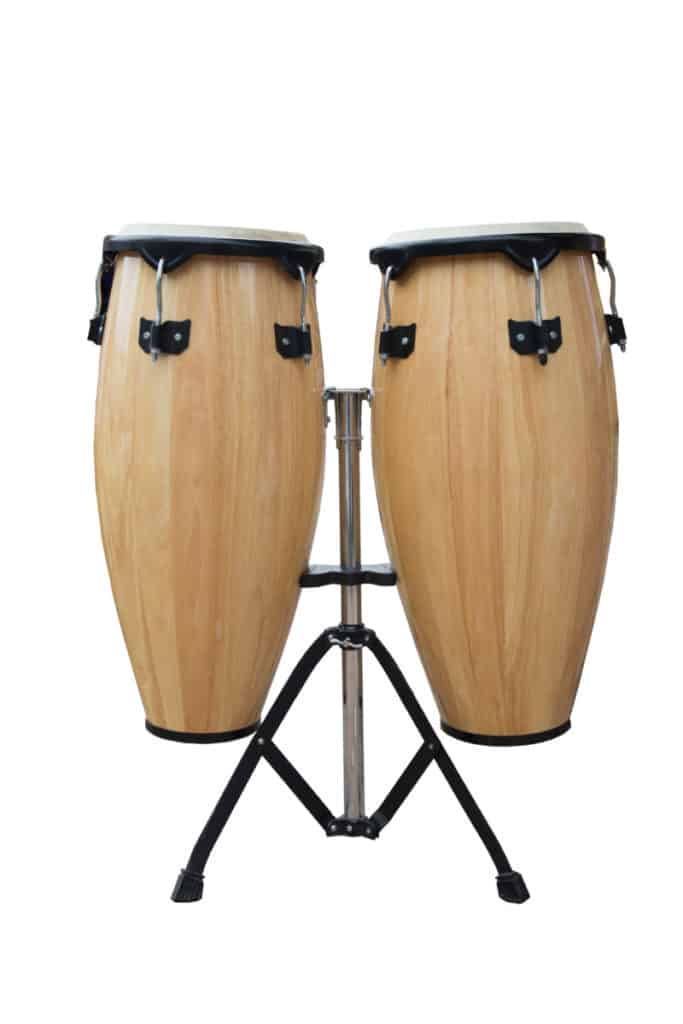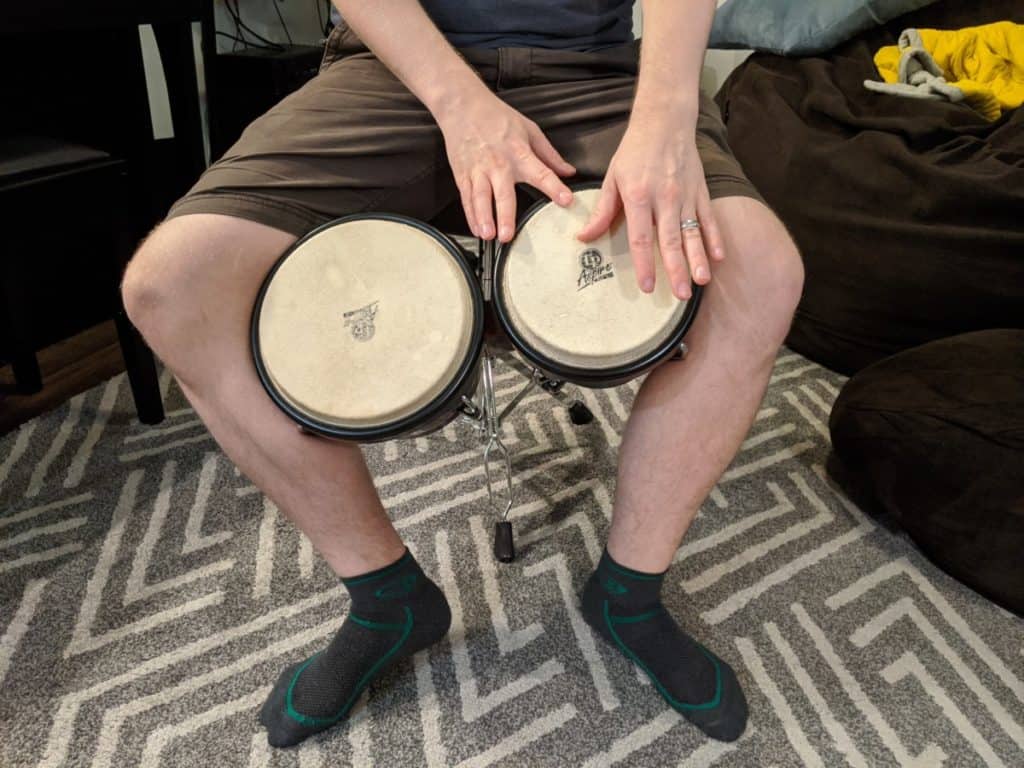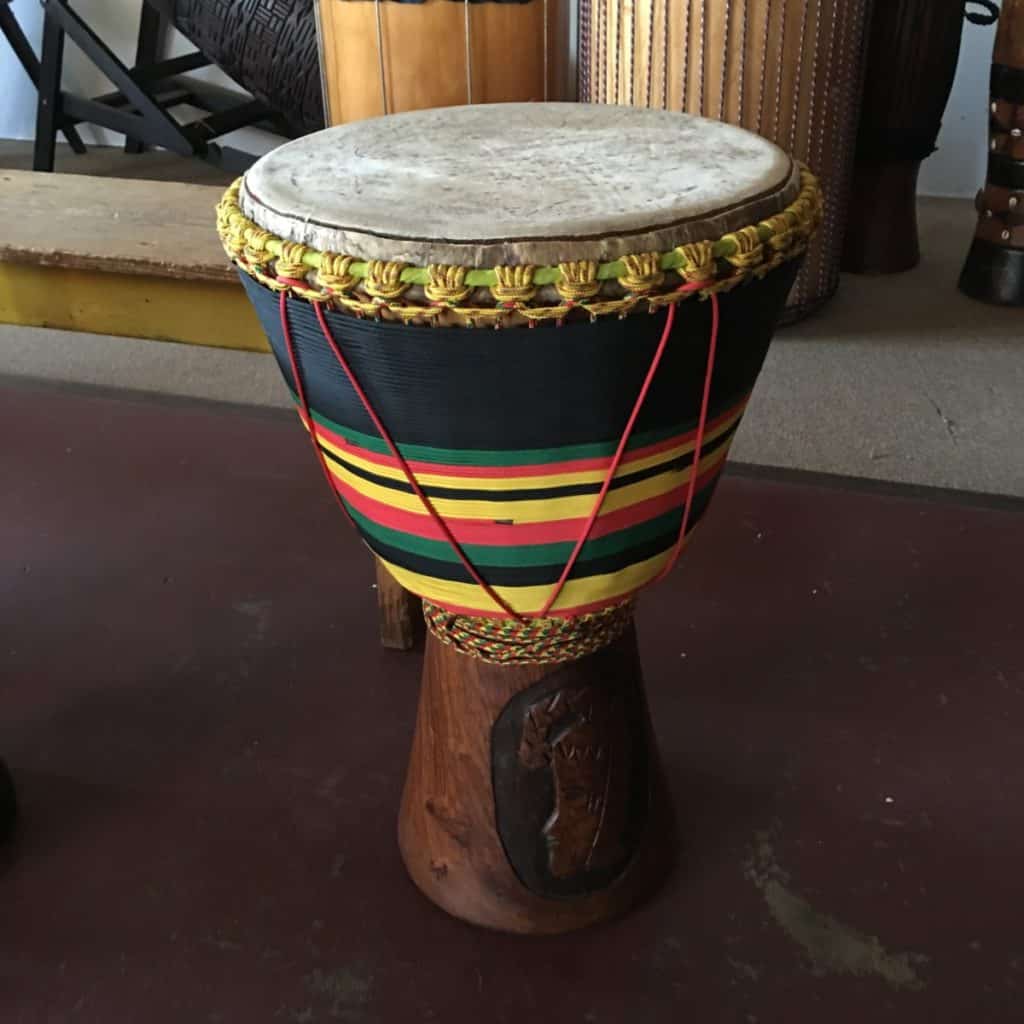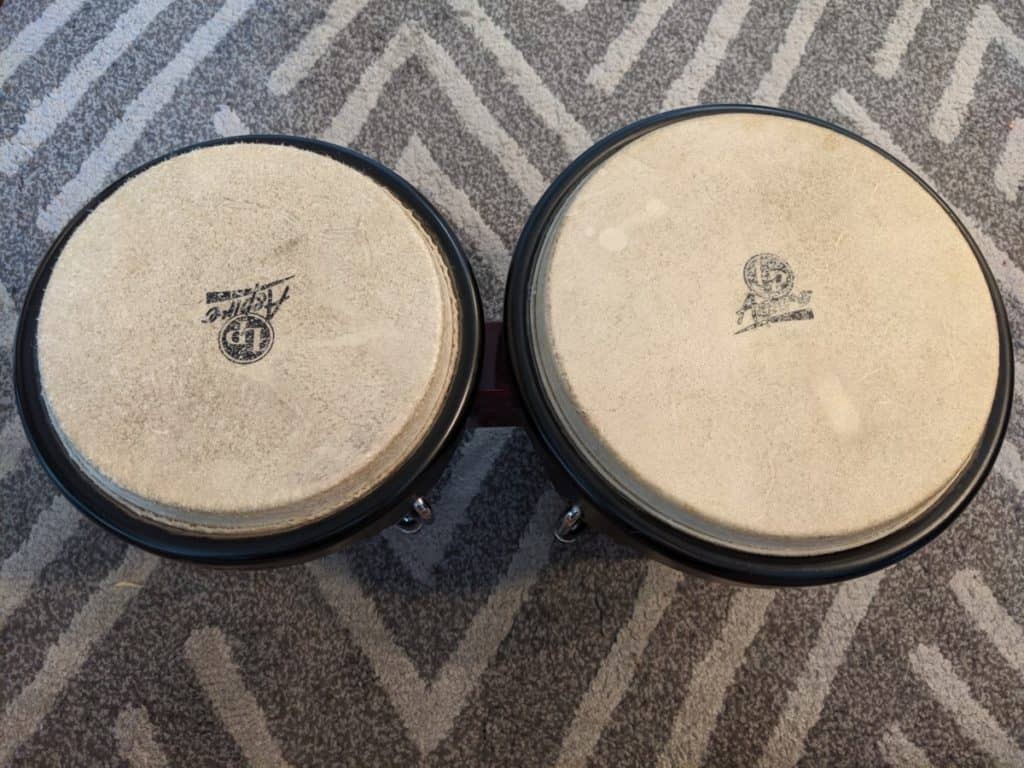This post contains affiliate links. We earn commissions if you purchase products from retailers after clicking on a link from our site. As an Amazon Associate, we earn from qualifying purchases.
It’s kind of overwhelming to get into hand percussion because there are so many different types of hand drums out there and it’s kind of intimidating! Especially when you call a drum by the wrong name, it’s a quick way to lose any street cred you’ve been working on.
This post is all about helping with many of these questions. By the end you’ll know so much more about the different types of hand percussion out there.
What Are Those Big Bongos Called?
There’s a lot of different drums out there, so it’s completely understandable to get some of these mixed up. In particular, if you saw those large drums that are around 4 feet long, you couldn’t be faulted to think of them as “big bongos”.
These tall drums are called congas and are a different type of drum then the bongos or a djembe.
A conga drum is fairly cylindrical with hardware attached to the body of the conga drum which tightens the drumhead. Congas are fairly tall drums and much bigger than bongo drums.

By the way, looking for recording equipment and musical instruments? Check out Sweetwater.com for microphones, monitors, audio interface or any other recording gear that you could ever need. (Affiliate Link)
Bongo drums are smaller and are meant to be held between your knees, like so:

Bongo drums are small drums that come in pairs–you won’t find a bongo drum that’s 3-4 feet tall.
These drums are both different from djembes. A djembe is another type of tall drum that is very wide and is often in an hourglass shape (often called a goblet shape), such as what you see here:

A djembe is tuned with ropes tightened around a hoop–it has a wide drumhead with an hourglass/goblet shape.
How Are Hand Drum Sizes Measured? (Bongos, Congas, and Djembes)
When you ask someone at your music store how big a bongo drum is, they’re going to tell you the drumhead size. This is by far the most common way to express how big a drum is. You might not be able to even find the width and height of a conga drum without measuring it yourself!
Sometimes the design of the drum is deliberately smaller or larger than normal and that’s where the manufacturer will discuss the actual dimensions of the drum itself.
So for example, even though Conga drums can be more than 2 feet in length, they will simply say that a conga drum is 9 inches.
This doesn’t mean the conga drum is 9 inches tall, it means the drumhead is 9 inches in diameter.
This is different than many other types of drums where drum “depth” is often discussed.
How Big are Bongo Drums?
Bongo drums come in pairs with the larger of the pair being called the hembra, and the smaller of the pair called the macho. These drums come in various sizes, such as the following.
| Width | Height | Drumhead Size |
| ~18 inches | ~10 inches | 6-9 inches |
Bongo drums come in pairs attached by a separate wood block, or (especially professional handmade quality bongo drums) are carved from a single block of wood. Hence, the width of the bongo drums is the width of the two drums attached at the center.

Bongo drum sizes do vary, but they are generally small enough to be played between the knees and you’ll only see at most a few inches in diameter differences.
How Big Are Conga Drums?
Conga drums are a bit more interesting and complicated when it comes to drum size. While bongos are just… bongos, and a djembe is just a djembe, a conga drum can have several different sizes:
What Are the Different Sizes of Conga Drums?
Conga drum sizes from smallest to biggest:
- Requinto/ Super Quinto
- Quinto (standard size)
- Conga (standard size)
- Tumba/Tumbadora (standard size)
- Super Tumba
| Most Common Height | Most Common Conga Drumhead Size | Drum Type |
| 30 inches | 9.75 | Super Quinto |
| 30 inches | 11 | Quinto |
| 30 inches | 11.75 | Conga |
| 30 inches | 12.5 | Tumba |
| 30 inches | 13.25 | Super Tumba |
I need to mention that the size of the drumhead is not really what defines whether a conga drum is a Tumba or a Conga or a Quinto, but it really is for differentiating the congas in a set. For example, some “Conga” drums were 11 inches in diameter, which is most commonly used for quinto conga drums.
The Super Quinto or Super Tumba sizes are not very common–typically the congas only come in 3 sizes: Quinto, Conga, or Tumba.
How Big Are Djembes?
Djembes are a completely different animal as far as drum size because djembes have so much individuality. An authentic djembe made in West Africa is completely unique and can never truly be reproduced.
However, drum sizes do follow some patterns–just know that you can see djembes that are only 12 inches tall, and then you can find some that are 30 inches tall–it all depends
| Most Common Height | Most Common Djembe Drumhead Size |
| ~24 inches | ~14 inches |
What Are Bongo, Conga and Djembe Drumheads Made From?
Hand drum drumheads can be made from all sorts of different materials–the traditional material, however, you’ll find is often an animal skin of some sort.
The most common animal skins used for drumheads are calf or goat skins, although hand drum players often experiment with many different types of animal skins.
Nowadays, though, hand drums can be found with synthetic drumheads which sound different but are strong and very consistent. These synthetic drumheads are similar to other drumheads found on a drumset, which is some form of plastic, often something similar to or composed of Mylar.
Why Are Bongo Drums Called Bongos?
Believe it or not, Bongo Drums do not get their name from Bongos (an antelope that lives on the African Continent), nor are their skins commonly (if ever) used for Bongo drums. Want more info or want to see what a Bongo antelope looks like? Check out our article that digs more into the subject, here.
There actually is no definitive answer as to where the name bongo comes from. X8Drums speculates an early bongo drum player named Bonko was the reason–but no-one knows for sure.
How Do You Hit the Bongos?
Bongos are hand drums, like Congas, or Djembes, but the techniques in which you play each of these instruments is different for each one.
All of the these drums are tuned differently and are of different sizes, thus they all have different sounds that you can make with each one.
Most hand drums have some form of the following tones:
- Open tone
- Muted Slap
- Muted Tap
- Rimshot
And there are many others.
Bongos are no exception, but the sounds you can make with the bongos are different from the other drums–and because of that, the style in which you play bongos, congas, or djembes is very different.
Bongo drums you typically use your fingers to play with an occasional hand slap, while congas and djembes are opposite you use your hands, primarily, and occasionally your fingers.
How Much Do Hand Drums (Bongos, Congas, Djembes) Cost?
As with anything, the range of cost for hand drums has large range. I’ll try and give you the three types of price ranges:
| Price Range | Drum Type | Quality Level |
|---|---|---|
| $40-$90 | Bongos | Beginner |
| $90-$200 | Bongos | Intermediate |
| $200-$500+ | Bongos | Professional |
| $300-$800 | Congas (Pair) | Beginner |
| $800-$1200 | Congas (Pair) | Intermediate |
| $1200+ | Congas (Pair | Professional |
| $70-$150 | Djembe (Adult Size) | Beginner |
| $150-$250 | Djembe (Adult Size) | Intermediate |
| $250+ | Djembe (Adult Size) | Professional |
Can You Play the Bongos With Sticks?
Bongos are designed to be hand drums, but often people want to try different types of sticks for various reasons–maybe you don’t want to use hands for health reasons, or maybe you’re looking to mount your bongo drums in a drumset, or maybe you just want a different sound.
The primary reason not to use sticks to play the bongos is that you can damage them. Due to the fact that bongos, congas, and djembes are hand drums, they have exposed bearing edges.
I go more into detail on this subject and explain how you can avoid damaging your drums when you play with sticks, as well as talk about different stick types that you can use to keep your drums safe here in this article.
So, if you are wanting to play a djembe, congas, or bongos with sticks, make sure you do not strike the bearing edge.
Are Bongo Drums African?
From the history we know, bongo drums were invented in Cuba, which has ancestry from the African continent. There is no doubt that the African heritage inspired the invention and design of bongo drums, even if the current design we use today did not definitively come from Africa.
What are Hand Drum Players Called?
There are different names for players of different hand drums:
- A bongo player is called a bongocera/bongocero
- A conga player is called a Tumbador, or more recently, a conguera/conguero
- A master djembe player: djembefola
It’s completely fine to just say bongo player, or conga player–there is no need to use a special term.
How To Pronounce Djembe
Whether or not there is an official pronunciation, the most common pronunciation for djembe is “jem-bay“.
How Are Djembes Made
I’ll walk through the process of how an authentic djembe from West Africa is made:
- A tree of the proper diameter is found and selected.
- The tree is cut down, and the traditional goblet shape is carved from the trunk of a tree. Djembes are essentially made from one block of wood.
- The drum is hollowed out with lots of work with cutting and grooving tools. Fire is used to assist in hollowing and conditioning the inside of the wood
- The drum is roughly carved to the eventual finished shape
- The drum is then finished and leveled out, which involves many hours of sanding and smoothing any rough edges. This is what makes the drum even enough to support a drumhead without issues
- Metal Hoops are formed to the circumference of the drum. One example of a design is to weld a hoop for the thinnest part of the drum, and then to have two hoops at the drumhead where the skins are tucked. This design varies from drum maker to another.
- A goat or calf skin is selected and used and is then stretched over the bearing edge of the drum and tightened by ropes tied to the “waist” of the drum and the metal hoops at the bearing edge.
Now, the djembe has become an instrument accepted worldwide, and therefore many other manufacturers make djembes.
A common method for making djembes is via the same process that congas and bongos are made, which is by using the stave method. Rather than carving the djembe out of a tree trunk as in the traditional method, the djembe is formed by bending several “staves” (blocks of wood) and gluing them together to form the djembe body.
After that, there are some djembes that are now made out of fiberglass or synthetic materials following completely different processes.
